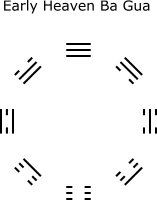
The monthly cycle of the moon's phases is a celestial marvel celebrated by romantics and mystics alike, and it is no surprise that it features prominently in myths from around the world.
To see how the sequence of the eight gua represents the lunar calendar we need only remember that yin lines (broken lines) symbolise shadow, while yang lines (whole lines) symbolise light.
The lunar phases shown below are depicted as they appear in the western sky (the direction of completion, understanding and wisdom).

The sequence of gua in the illustration above is not arbitrary but is Fu Xi's own. To see this, we can simply read his circular arrangement (shown below) clockwise from the bottom, viewing the gua as if from the centre.

Although the half moon gua are not exact images of the phases they represent, they are even more remarkable: the proportion of yin and yang lines reveal the movement of the phase. The waxing phase, where the moon is becoming lighter towards fullness, has two yang lines and only one yin line; neatly depicting the increasing importance of the light. The waning phase, on the other hand, has two yin lines and only one yang, revealing its movement towards shadow.
The waxing and waning of the moon is analogous to both the annual solar cycle of summer and winter, and the daily rhythm of day and night. The mapping of both the year and the day onto Fu Xi's circular arrangement is simple and straightforward (although we need to remember the Chinese traditionally place south at the top of their maps, not north as is the custom in the West).
East (with all its connotations of sunrise, beginnings, new life, and springtime) is to the left hand side of the circle, corresponding exactly with the waxing half moon. Likewise, south, at the top of the circle, represents noon, the height of summer, as well as the full moon, and is appropriately composed of all yang lines.
These overlapping layers of meaning repay careful consideration and can provide profound insights into the origins and symbolism of the Early Heaven system.
Surely, such carefully integrated ideas should not, as has been the case for more than three millennia, be dismissed as lacking relevance to modern life.
For additional information on the relevance of the moon to the Early Heaven sequence of gua, see Taiji Tu.
© Ken Taylor 2002 - 2006